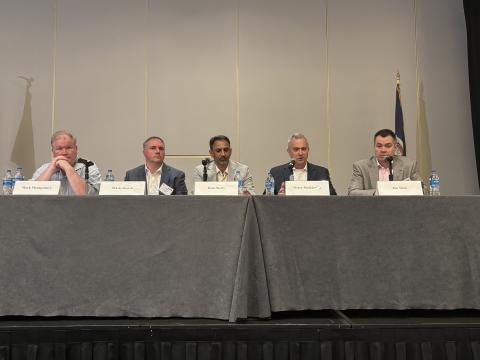Current Trends in Intelligence Outsourcing Affect Work Force Stability
Accountability and financial controls are part of the solution for cost-effective outsourcing.
The attacks on the
Outsourcing of intelligence activities raises questions of both financial costs and accountability. It is an intricate activity for which the line of inherently governmental functions is rapidly disappearing and for which there has been little or no congressional oversight. By early 2007, the intelligence community’s budget was estimated at more than $43.5 billion, although the exact budget, contracting activities and operations are classified.
Intelligence activities conducted by private contractors are indispensable in the Global War on Terrorism, but rapid outsourcing activity can result in wasteful spending, destabilization of the work force structure and contract management problems. In May 2007, the Senate Select Committee on Intelligence (SSCI) requested a study on the community’s civilian and contractor work force and the appropriate use of contractors.
The executive branch, Congress and private industry encounter three key issues in dealing with intelligence outsourcing: the financial costs associated with outsourcing; the identification of intelligence activities that are inherently governmental functions; and the accountability in private contracting.
Since the end of the Cold War, a demand for a peace dividend has left the community bereft of new resources to sustain and expand its capabilities. Encouraged by then Vice President Al Gore’s National Partnership for Reinventing Government initiatives in the mid-1990s, the community began to outsource non-core functions to lower the operating costs and upgrade its legacy infrastructures. Outsourced functions included business processes and information technology management and infrastructures. Because of the shortage of skilled analysts and the lack of technical expertise in key issues such as weapon proliferation and terrorism, the community quickly accelerated its outsourcing activities. The pressing need for intelligence support to military operations in the global battlefields, combined with staff ceilings imposed by Congress, have compounded the difficulty in managing the mission adequately with internal resources. Currently, the intelligence outsourcing industry is pervasive in providing every intelligence agency with contracting staffs, who perform a diverse set of functions from crafting intelligence requirements to delivering situation reports to
Since the mid-1990s, intelligence outsourcing has increased 38 percent to reach $42 billion in 2005, with an estimate of 60,000 to 70,000 contracting personnel. According to multiple press accounts, more than $34 billion, or 70 percent of the intelligence community’s budget for fiscal year 2007, was spent on private contractors for tasks ranging from intelligence collection to dissemination. Media reports suggest that 60 percent of the Central Intelligence Agency is supported by contractors, and 70 percent of its counterintelligence field activities are as well.
Congress estimated that the government spent on average $126,500 annually to support a full-time intelligence civilian. At least $250,000 is necessary to support a core contractor with overhead fees. Many supporters of outsourcing argued that even though a core contractor costs substantially more than a full-time civilian, the total expenditure to pay for the civilian benefits and retirements far exceeds the short-term cost.
Outsourcing should be distinguished from the practice of using outside contractors to expand the work force only for certain missions. Outsourcing is structured to be a long-term solution for cost effectiveness. Using contractors for specific missions can be a solution to short-term needs, but it could have negative long-term impact. The government cuts costs only if it uses such contractors in the short term. If the government grew to depend on these contractors for the core mission indefinitely, the future consequences would be disastrous.
Outsourcing has created serious challenges for the intelligence community. The Office of the Director of National Intelligence (ODNI) indicated in its five-year Strategic Human Capital plan that the community was competing with contractors for experienced and talented employees. It lamented that contracting companies are recruiting the civilian personnel and then “leasing” them back at a higher cost. Approximately 65 percent to 70 percent of new contractors with clearances come from the military, and these are often the same people who are trained by the intelligence agencies. The prime contracting companies usually offer the community’s civilian and military personnel an additional 35 percent to 50 percent salary increase to perform the same tasks as civilian employees.
This practice negatively affects the morale of those who perform those tasks for significantly lower pay. The community made a considerable investment in its employees; however, it could not provide enough incentives to retain those employees because of staffing ceilings and inflexible funding. Without any leverage, the community cannot retain personnel to develop expertise on complex issues, maintain and transfer organizational knowledge or acquire skills and knowledge to manage the civilian work force. If the ongoing issues are not resolved, these problems will eventually damage the community’s work force structure.
The community is debating which functions it can outsource. The common practice is to define core and non-core tasks and to outsource the non-core tasks. However, the ODNI revealed that the current constraints and pressing requirements have forced the community to use contractors to perform core tasks that are “borderline inherently governmental.” As defined in the Office of Management and Budget Circular A-76, “inherently governmental functions” are activities that have strong public interests that should be performed only by government personnel. These include “the exercise of sovereign government authority or the establishment of procedures and processes related to the oversight of monetary transactions or entitlements.” In regard to intelligence matters, the Defense Federal Acquisition Regulation Supplement (DFARS) further interpreted that the direction and control of intelligence and counterintelligence operations are considered “inherently governmental.” In May 2007, Congress asked the director of national intelligence to study the contracting work force and address whether contractors are performing inherently governmental functions.
Intelligence outsourcing and inherently governmental functions are murky areas that need further study. Intelligence activities, such as the handling of human intelligence assets, analysis of terror threats and briefing of intelligence operations to field commanders, already are performed by contractors. William Lahneman, an intelligence scholar at the
The current intelligence contracting environment suggests that Lahneman’s analysis for outsourcing candidates is almost parallel to the community’s practices. In the realm of intelligence analysis, private intelligence contractors already are providing a diverse set of analysts from counterintelligence to cyber threat analysis to the defense and intelligence communities. Evidence suggests that private contractors have played the roles of HUMINT handlers and that contractors have performed both intelligence production and dissemination, such as daily intelligence briefings to the military commanders in Iraq, that may cross into the realm of inherently governmental functions.
In the Senate’s Intelligence Authorization fiscal year 2008, the SSCI concluded that the community’s leadership does not have the full understanding of the current contractor work force and the short- and long-term issues associated with intelligence outsourcing. If the leadership cannot recognize the scope of the problem, it will be extremely difficult to hold intelligence contractors accountable for their actions. Although there is no definitive study to address problems in intelligence outsourcing, financial and personnel problems exist that show a lack of accountability.
In the Abu Ghraib prison in
Trailblazer is another example. This project was the National Security Agency’s effort to perform signals intelligence collection, processing and analysis to include discovery and retrieval of a key adversary’s communications. However, by early 2006, the project was largely abandoned with a cost of approximately $1.2 billion and six years of research and development. Contractors were not held accountable for their failure to deliver. Major reasons for failure included the lack of strategy and insufficient contract management by the civilian leadership. Supporting contractors lacked program management and technical skills. Those contractors also failed to invent new tools to solve complex requirements and under-performed in key requirements.
Outsourcing issues extend beyond the intelligence arena as well. Congress has indicated that outsourcing portions of procurement activities, in the examples of the Coast Guard’s Deepwater and Army’s Future Combat Systems programs, led to problems of transparency and oversight. Congress noted that these defense companies had been given unprecedented authority by the government, which led to changes in the source-selection procedures unregulated by DFARS, poor product quality, cost overrun and schedule slippage because of a lack of independent performance assessments. Although the intelligence agencies might independently determine their core and noncore functions, allowing contractors to take on inherently governmental functions would leave all of the accountability to those responsible agencies.
To sustain and strengthen
Vinh Nguyen is an analyst at the
Web Resources
OMB Circular A-76: www.whitehouse.gov/omb/circulars/index.html
The Defense Federal Acquisition Regulation Supplement: www.acq.osd.mil/dpap/dars/dfars/index.htm
Intelligence Authorization Act for FY 2008: www.fas.org/irp/congress/2007_rpt/hrpt110-131.html




Comments